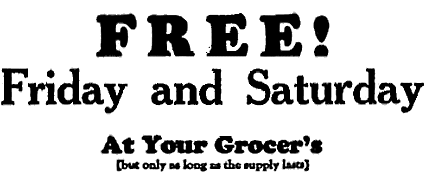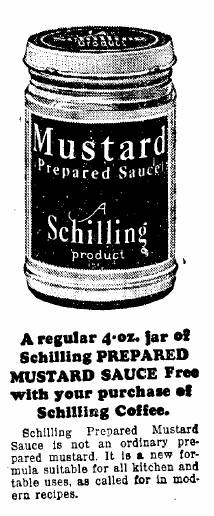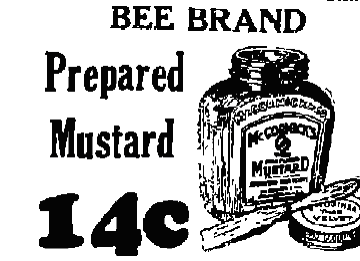Metropolitan News-Enterprise
Thursday,
January 27, 2005
Page
15
REMINISCING (Column)
Add Liquid to Dry Mustard, and Voila! A New Product for Spice Companies
By
ROGER M. GRACE

That was the heading on a large advertisement for A.
Schilling & Company published in the Hayward (Calif.) Review
on Feb. 27, 1930.
There would be a free 2-ounce tin of Schilling
Cinnamon going to anyone purchasing the company’s tea, the ad explained, and a
1-ounce bottle of “maple” (presumably syrup) going to any purchaser of Schilling
Baking Powder. And to those paying for Schilling coffee, there would be a
4-ounce jar of Schilling Prepared Mustard Sauce, a new product of the San
Francisco-based company.
The ad would appear in a newspaper in Hayward
one week; another week it would be published in a Reno, Nevada paper; another
week in Bismarck, North Dakota.
Schilling had a traveling spice display, with its
impending arrival in town announced in ads in the local press. The specials
might be for the week, Friday and Saturday, or just Saturday. There was some
variation in the products offered, but a special on prepared mustard was a
constant.
 |
|
It was by this-by-city approach in 1930 that Schilling
introduced its prepared mustard to consumers from the West Coast to the Great
Plains.
It made sense for Schilling,
a spice company founded in 1881, to launch a prepared mustard. It was already
selling a leading brand of ground dry mustard.
In powdered form, mustard is considered a spice. Once
water, vinegar, or some other liquid is added, it’s a condiment. By adding some
liquid to its dry mustard, and presumably some other spices, Schilling in 1929
became a condiment maker.
Another spice company that was selling dry mustard
likewise had undertaken—several years earlier—to wet its product and render
it a ready-to-use one. McCormick & Co., founded in 1889 in Baltimore,
Maryland, marketed prepared mustard in the east under the “Banquet” brand
starting in 1902, and also used its “Bee” brand label, commencing in 1897.
|

From
a 1929 grocery store ad
|
|
In 1947, McCormick
bought out Schilling, though the demise of that
company was not apparent in the western half of the U.S. For years, McCormick
perpetuated the use of the Schilling brand name here, while employing its own
moniker in the east, and other labels in Canada and the U.K.
It continued manufacturing Schilling’s Prepared
Mustard at least through the early 1950s.
Gradually
over the past few years, McCormick has phased out the Schilling name.
My wife and I have in our pantry a small cylindrical
cardboard container of ground black pepper bearing the Schilling logo. Turning
it 180 degrees, the McCormick logo appears. This was apparently transitional
branding.
Nowadays, the only place you’ll possibly find
Schilling products is in your cupboard. (My wife and I have some Schilling food
colorings which we used for tinting Easter eggs, to the delight of our
daughter. Given that she’s now an attorney, real estate broker, and publisher
of her own newspaper, you’d be correct in assuming that the dyes are not of
recent vintage.)
McCormick remains in the mustard
business. It markets a dry mustard and mustard seeds.
Additionally, in 2003, it purchased Zatarain brand for $180 million, becoming
the maker of Zatarain’s Creole mustard and its Creole mustard and herb sauce,
as well as its chow chow (mustard and pickle relish).
Ironically, Emile
A. Zatarain Sr of New
Orleans began his
business operations in 1889, the same year as Willoughby M. McCormick of Maryland. Both of their companies from the start made root
beer.
Copyright 2005, Metropolitan News Company
MetNews Main Page Reminiscing Columns


